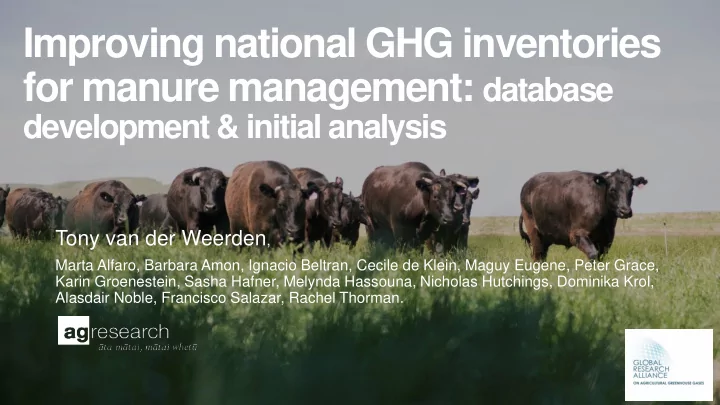

Improving national GHG inventories for manure management: database development & initial analysis Tony van der Weerden , Marta Alfaro, Barbara Amon, Ignacio Beltran, Cecile de Klein, Maguy Eugene, Peter Grace, Karin Groenestein, Sasha Hafner, Melynda Hassouna, Nicholas Hutchings, Dominika Krol, Alasdair Noble, Francisco Salazar, Rachel Thorman.
GHG emissions along the manure management chain CEDERS Focus of DataMan • Systems approach Housing Storage Field • From Animal diet (CEDERS) to Land application, including animal grazing Animal diets - Low protein diets Animal • Example shown for liquid housing manure management - Manure Manure removal treatment - Anaerobic Manure digestors covers - Acidification - Covers Animal Manure Grazing application - Soil conditions - Shallow injection Modified from Sajeev et al. 2017
GHG emissions from manure management Methane (CH 4 ) • anaerobic lagoons, liquid and slurry storage Nitrous oxide (N 2 O) • solids and slurry storage (semi-anaerobic), deep bedding, land application, excreta from grazing. Ammonia (NH 3 ) – indirect source of N 2 O • livestock housing, manure storage, land application, excreta from grazing Transformation of organic material -> TAN, CH 4, CO 2 etc.
DataMan: Expected outputs & benefits Publicly accessible GHG emissions database – available for future expansion. 1. 2. Functional relationships between key variables and EFs identified. 3. Mitigation options identified. 4. Disseminate findings & case studies to industry & governments on mitigation options and how to improve inventories.
Approach • Identify key variables affecting N 2 O, NH 3 and CH 4 emissions from manure management: • housing • storage • land-application, • and direct deposition by livestock. • Develop algorithms and emission factors for use in Tier 2 national GHG inventory methodologies for developed and developing countries. • Identify potential mitigation options
Partners • New Zealand • UK • Ireland • Denmark • France • Germany • Netherlands • Chile • Australia Data also sourced from Argentina, Brazil, Canada, China, Colombia, Italy, Kenya, Nicaragua, Norway, Sweden, Switzerland, Vietnam, and Zimbabwe.
Key steps of Dataman
Country Housing Storage Field ✓ ✓ Argentina ✓ Australia ✓ ✓ ✓✓ Brazil ✓✓ Canada Database description ✓ Chile ✓ ✓ ✓ China ✓ Colombia GHG Housing Storage Field ✓ Kenya (emission rate) (emission rate or (emission ✓✓ Denmark cumulative loss) factors) ✓ France NH 3 24 37 1243 ✓ Germany ✓ N 2 O 4 53 2133 Ireland ✓ Italy CH 4 5 45 - ✓✓ Netherlands ✓ Nicaragua Combines existing databases: ALFAM2 (Denmark), AEDA ✓ Norway (UK), N 2 O DB (NZ) ✓✓ NZ Still to be included: ELFE (France) – ca July 2019 ✓✓ UK ✓ Sweden ✓ Switzerland ✓ Vietnam ✓ Zimbabwe
Manure Livestock Manure Manure types application types treatments method Field Database solid Dairy Cattle none shall inject manure(FYM) Beef cattle slurry covered deep inject. Swine layer manure compacted broadcast Poultry broiler litter forced aeration bandspread Sheep dirty water solid separation trailing shoe dung digestion trailing hose urine composted field acidification barn acidification drying urease inhibitor nitrification inhibitor
Field Database: what does NH 3 data look like? NH 3 emission factors (Frac GASM ) for liquid and slurry
Field Database: what does N 2 O data look like? N 2 O emission factors for slurry (EF 1 ) and dung & urine (EF 3 )
Drivers of N 2 O from dairy cattle urine: NZ example • Rainfall - L/T monthly average EF 3 - actual in 30 days following urine • Volumetric water content (v/v) P < 0.0001 • Volumetric air content (v/v) • Water filled pore space (WFPS, %) • Relative diffusivity (Dp/Do) • Temperature • Soil bulk density P < 0.0001 • Soil pH P = 0.031 • Soil clay content • Soil organic C concentration P = 0.029 • Soil cation exchange capacity (CEC) R 2 = 47% • N supply
Next steps • Continue data collation • Complete data analysis using available data • Initiate potential improvements to national inventories using case studies (NZ, Chile) ➢ Looking to add more case study countries. • Investigate a possible DataMan extension project ➢ Happy to include more countries, more data.
Acknowledgements Funding: ➢ NZ Govt via Global Research Alliance (NZ and Chilean scientists) ➢ UK Govt via Defra (UK scientists) ➢ In-kind support from other European institutes (INRA, ATB, Aarhus University, Teagasc, WUR) Researchers for data!!
Recommend
More recommend